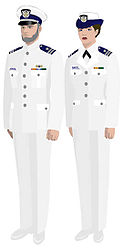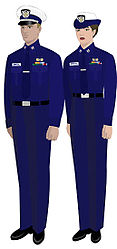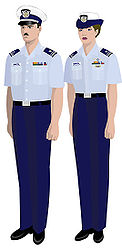The United States Air Force officer rank insignia in use today.

The United States Coast Guard Auxiliary is the uniformed civilian volunteer force, acting as an auxiliary force multiplier for the United States Coast Guard. Congress established the unit on 23 June 1939, as the United States Coast Guard Reserve. On February 19, 1941, the entity was renamed the United States Coast Guard Auxiliary. The Auxiliary's purpose is to bolster all USCG undertakings both at sea and in the sky, with the exception of tasks necessitating "direct" law enforcement or military actions. As of 2022, the U.S. Coast Guard Auxiliary boasted around 21,000 members.

The Battle Dress Uniform (BDU) is a camouflaged combat uniform that was used by the United States Armed Forces as their standard combat uniform from the early 1980s to the mid-2000s. Since then, it has been replaced or supplanted in every branch of the U.S. Armed Forces.

Mess dress uniform is the most formal type of evening-wear uniform used by military personnel, police personnel, and other uniformed services members. It frequently consists of a mess jacket, trousers, white dress shirt and a black bow tie, along with orders and medals insignia. Design may depend on regiment or service branch, e.g. army, navy, air force, marines, etc. In modern Western dress codes, mess dress uniform is the supplementary alternative equivalent to the civilian black tie for evening wear. Mess dress uniforms are typically less formal than full dress uniform, but more formal than service dress uniform.

A blazer is a type of jacket resembling a suit jacket, but cut more casually. A blazer is generally distinguished from a sport coat as a more formal garment and tailored from solid colour fabrics. Blazers often have naval-style metal buttons to reflect their origin as jackets worn by boating club members.

Sea Scouts is a program of the Boy Scouts of America for young men and women ages 14 through 20.

Full dress uniform, also known as a ceremonial dress uniform or parade dress uniform, is the most formal type of uniforms used by military, police, fire and other public uniformed services for official parades, ceremonies, and receptions, including private ones such as marriages and funerals. Full dress uniforms typically include full-size orders and medals insignia. Styles tend to trace back to uniforms used during the 19th century, although the 20th century saw the adoption of mess dress-styled full-dress uniforms. Designs may depend on regiment or service branch. In Western dress codes, full dress uniform is a permitted supplementary alternative equivalent to the civilian white tie for evening wear or morning dress for day wear – sometimes collectively called full dress – although military uniforms are the same for day and evening wear. As such, full dress uniform is the most formal uniform, followed by the mess dress uniform.

The uniforms of the United States Navy include dress uniforms, daily service uniforms, working uniforms, and uniforms for special situations, which have varied throughout the history of the navy. For simplicity in this article, officers refers to both commissioned officers and warrant officers.
The uniforms of the Canadian Armed Forces are the official dress worn by members of Canada's military while on duty.

A physical training uniform is a military or organizational uniform used during exercise, calisthenics, drills, and in some cases, very casual periods of time. Most militaries, especially the United States Armed Forces and their auxiliaries require use of a physical training (PT) uniform during unit exercise. All items worn by military personnel conducting PT as a group are subject to uniformity, at commander discretions, however, some U.S. military units produce unique T-shirts with their unit insignia and motto, and for special events, this shirt is part of the uniform. Occasionally, exercise will also be conducted in that branch's utility uniforms, normally with the blouse removed and the undershirt exposed. For unit runs, esprit de corps or special occasions, commanders may have personnel wear unique T-shirts with the distinctive unit insignia and unit colors.

Service dress uniform is the informal type of uniform used by military, police, fire and other public uniformed services for everyday office, barracks and non-field duty purposes and sometimes for ceremonial occasions. It frequently consists of a jacket, trousers, dress shirt, and neck tie, along with orders, medals, and insignia. Design may depend on regiment or service branch, e.g. army, navy, air force, marines, etc. In Western dress codes, a service dress uniform is a permitted supplementary alternative equivalent to the civilian suit - sometimes collectively called undress or "dress clothes". As such, a service dress uniform is considered less formal than both full dress and mess dress uniforms, but more formal than combat uniforms.

The United States Marine Corps (USMC) prescribes several types of military uniform to distinguish its service members from other armed services, depending on the situation.
The Operational Dress Uniform (ODU) is the normal work uniform of the United States Coast Guard, the U.S. Coast Guard Auxiliary, the National Oceanic and Atmospheric Administration Commissioned Officer Corps, and the U.S. Public Health Service Commissioned Corps (PHSCC). It is also one of the uniforms worn by the New York Naval Militia.

The Royal Air Force uniform is the standardised military dress worn by members of the Royal Air Force. The predominant colours of Royal Air Force uniforms are blue-grey and Wedgwood blue. Many Commonwealth air forces' uniforms are also based on the RAF pattern, but with nationality shoulder flashes. The Royal Air Force Air Cadets wear similar uniforms.
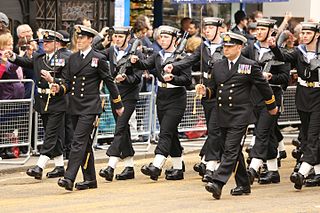
The uniforms of the Royal Navy have evolved gradually since the first uniform regulations for officers were issued in 1748. The predominant colours of Royal Navy uniforms are navy blue and white. Since reforms in 1997 male and female ratings have worn the same ceremonial uniform.
The uniforms of the United States Army distinguish soldiers from other service members. U.S. Army uniform designs have historically been influenced by British and French military traditions, as well as contemporary U.S. civilian fashion trends. The two primary uniforms of the modern U.S. Army are the Army Combat Uniform, used in operational environments, and the Army Green Service Uniform, worn during everyday professional wear and during formal and ceremonial occasions that do not warrant the wear of the more formal blue service uniform.

The Singapore Police Force has employed several different styles of uniforms throughout its history. Since 1969 it has used dark blue for its uniforms, although the first police uniforms introduced in 1856 were also in the same colour.
The uniforms of the Royal Canadian Navy are a variety of different official dress worn by members of the Royal Canadian Navy while on duty. Originally, the uniforms of the RCN were modelled after their counterparts from the United Kingdom. However, after the RCN was merged with the Canadian Army, and the Royal Canadian Air Force in 1968 to form the single-service Canadian Armed Forces, the RCN began to wear "Canadian Armed Forces Green" uniforms, worn throughout the Canadian Armed Forces
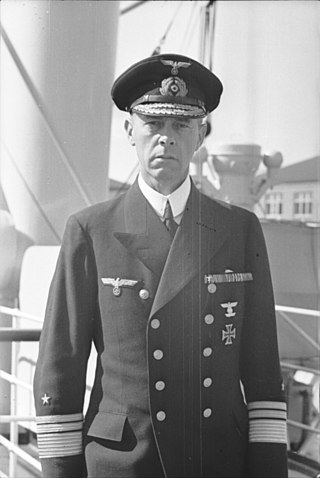
The Kriegsmarine was the navy of Nazi Germany prior to and during World War II. Kriegsmarine uniform design followed that of the preexisting Reichsmarine, itself based on that of the First World War Kaiserliche Marine. Kriegsmarine styles of uniform and insignia had many features in common with those of other European navies, all derived from the British Royal Navy of the 19th century, such as officers' frock coats, sleeve braid, and the "sailor suit" uniform for enlisted personnel and petty officers.
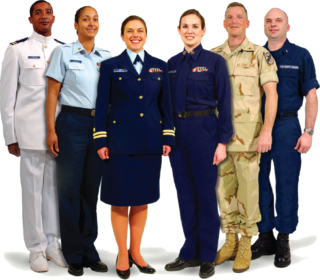
The Uniforms of the United States Coast Guard include dress uniforms, daily service uniforms, working uniforms, and uniforms for special situations, which have varied throughout the history of the USCG.

